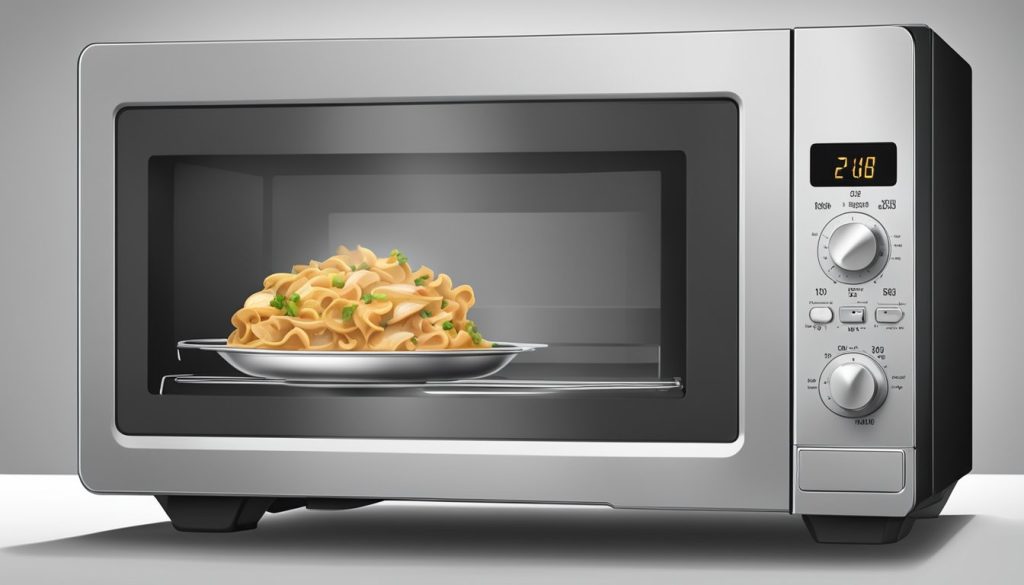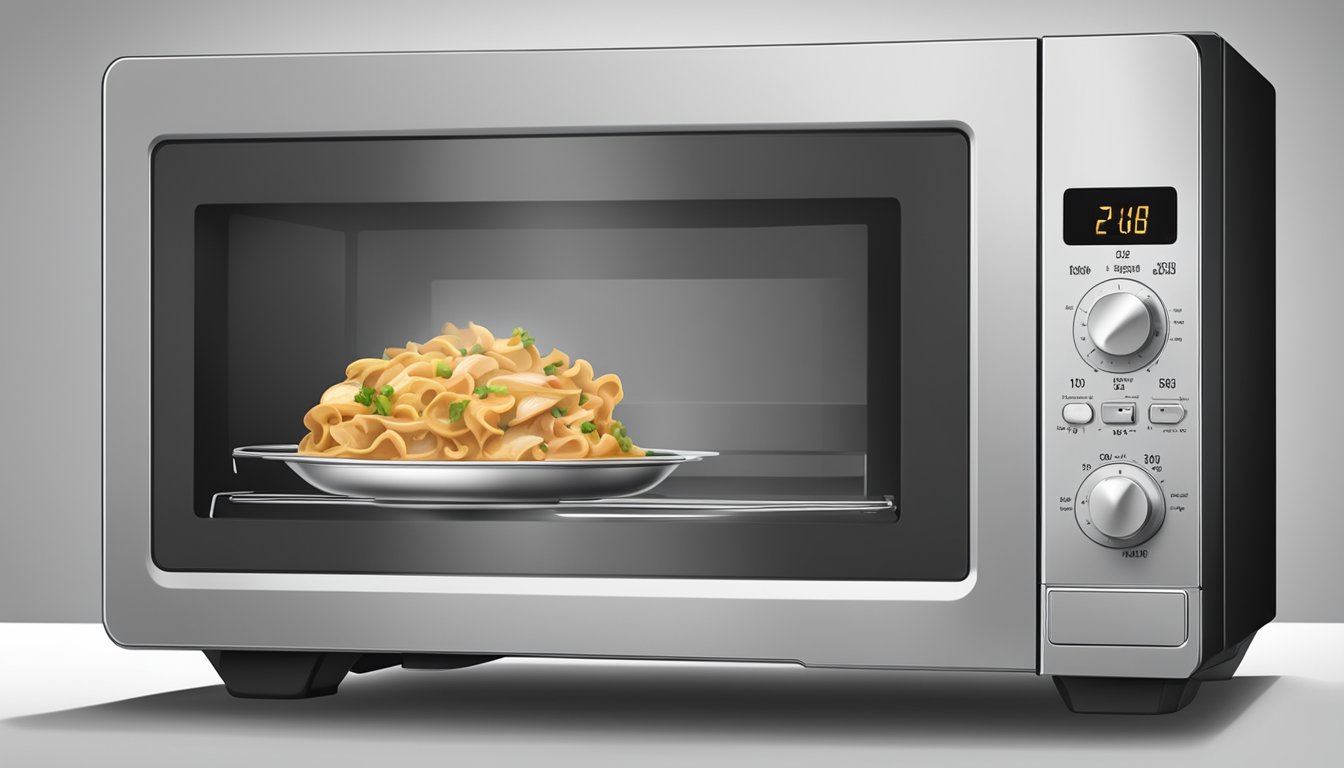Chicken stroganoff is a beloved comfort food that can be just as delicious when reheated properly. Bringing this creamy pasta dish back to life requires careful attention to preserve its texture and flavors. The most effective methods for reheating chicken stroganoff include using an oven, stovetop, or microwave, with the oven method often producing the best results.

Reheating techniques for chicken stroganoff vary, but all aim to maintain the dish’s moisture and prevent the sauce from separating. When using the oven, placing the stroganoff in a covered dish with a splash of liquid helps retain its creamy consistency. Stovetop reheating allows for easy stirring and temperature control, while microwaving offers a quick solution for smaller portions.
Properly reheated chicken stroganoff can taste nearly as good as when freshly made, making it an excellent option for leftovers. By choosing the right reheating method and following a few simple steps, anyone can enjoy this comforting meal without sacrificing its original quality and taste.
Understanding Chicken Stroganoff
Chicken stroganoff is a flavorful dish featuring tender chicken pieces in a rich, creamy sauce. This popular variation of the classic Russian recipe offers a delightful blend of textures and tastes.
History and Origin
Chicken stroganoff evolved from the original beef stroganoff, a dish created in 19th century Russia. Named after Count Pavel Stroganoff, the beef version gained popularity in aristocratic circles.
As the recipe spread globally, chefs began experimenting with different proteins. Chicken emerged as a lighter alternative, appealing to those seeking a less heavy meal.
The transition to chicken maintained the essence of the original dish while offering a new flavor profile. This adaptation allowed the stroganoff to reach a wider audience and become a staple in many cuisines worldwide.
Chicken Stroganoff vs. Beef Stroganoff
While sharing similarities, chicken and beef stroganoff have distinct characteristics:
- Protein: Chicken stroganoff uses tender chicken pieces, while beef stroganoff features strips of beef.
- Cooking time: Chicken cooks faster than beef, resulting in a quicker preparation.
- Flavor profile: Chicken offers a milder taste, allowing the sauce flavors to shine.
- Texture: Chicken provides a softer texture compared to the chewier beef.
Both versions typically include mushrooms, onions, and a creamy sauce. The choice between chicken and beef often comes down to personal preference or dietary considerations.
Key Ingredients
Chicken stroganoff combines several essential components:
- Chicken: Boneless, skinless chicken breast or thighs, cut into bite-sized pieces
- Mushrooms: Button or cremini mushrooms, sliced
- Onions: Thinly sliced for flavor and texture
- Sauce base: Chicken stock, sour cream, and sometimes white wine
- Seasonings: Salt, pepper, paprika, and sometimes mustard
- Thickener: All-purpose flour or cornstarch
- Aromatics: Garlic and fresh parsley for added depth
The creamy sauce, a hallmark of stroganoff, is typically made by combining sautéed mushrooms and onions with chicken stock and sour cream. Flour helps thicken the sauce, creating its signature velvety texture.
Initial Preparation and Cooking

Mastering the initial steps of preparing chicken stroganoff sets the foundation for a delicious meal. Proper ingredient selection and cooking techniques are crucial for achieving the perfect balance of flavors and textures.
Selecting the Right Chicken
Choose skinless chicken breasts for a leaner option. Look for fresh, plump pieces with a pale pink color. Trim any excess fat and slice the chicken into bite-sized strips about 1/2 inch thick. This ensures even cooking and easy eating.
Pat the chicken dry with paper towels to remove excess moisture. This step is essential for achieving a good sear.
Season the chicken strips with salt, pepper, and paprika. For added depth, include a dash of smoked paprika.
Sautéing the Chicken and Vegetables
Heat olive oil in a large skillet over medium-high heat. Add the seasoned chicken strips in a single layer, working in batches if necessary to avoid overcrowding.
Cook for 3-4 minutes per side until golden brown. Remove the chicken and set aside.
In the same pan, sauté finely diced yellow onion until translucent. Add minced garlic and cook for another minute.
Slice cremini mushrooms and add them to the pan. Cook until they release their moisture and turn golden brown.
Creating the Creamy Mushroom Sauce
Deglaze the pan with white wine, scraping up any browned bits. Let it simmer until reduced by half.
Lower the heat and stir in sour cream. Add Dijon mustard for tanginess and depth.
Gradually incorporate chicken broth, stirring constantly to create a smooth sauce.
Season with additional paprika, salt, and pepper to taste. Simmer gently until the sauce thickens slightly.
Return the cooked chicken to the pan and let it warm through in the sauce for 2-3 minutes.
Proper Storage Techniques

Proper storage is crucial for maintaining the quality and safety of chicken stroganoff. Following the right techniques ensures the dish remains delicious and safe to eat when reheated.
Cooling Down and Storing Leftovers
Allow chicken stroganoff to cool to room temperature within 2 hours of cooking. Divide it into shallow, airtight containers to promote rapid cooling. Refrigerate promptly at 40°F (4°C) or below.
Label containers with the date to track freshness. Consume refrigerated leftovers within 3-4 days for best quality and safety.
To prevent bacterial growth, avoid leaving chicken stroganoff at room temperature for extended periods. Use clean utensils when portioning to minimize contamination.
Store sauce and noodles separately if possible. This prevents noodles from absorbing excess moisture and becoming soggy.
Freezing Chicken Stroganoff
For longer storage, freeze chicken stroganoff in airtight containers or heavy-duty freezer bags. Remove as much air as possible to prevent freezer burn.
Freeze within 2 hours of cooking for optimal quality. Properly frozen, it can last 2-3 months.
Label containers with the dish name and freezing date. Freeze sauce and noodles separately for best results.
Thaw frozen stroganoff in the refrigerator overnight before reheating. Avoid thawing at room temperature, which can promote bacterial growth.
Use frozen chicken stroganoff within 1-2 days after thawing for best taste and texture.
Reheating Chicken Stroganoff

Properly reheating chicken stroganoff preserves its creamy texture and tender meat. Three effective methods ensure the dish retains its original flavors and consistency.
Oven Reheating Method
Set the oven to 350°F (175°C). Place the chicken stroganoff in an oven-safe dish and cover with foil. This prevents moisture loss and promotes even heating. Add a tablespoon of water or broth to maintain creaminess.
Heat for 15-20 minutes, stirring halfway through. For larger portions, extend the heating time. Check the internal temperature reaches 165°F (74°C) for food safety.
Remove the foil for the last 5 minutes to allow any excess moisture to evaporate. This method ensures a consistently heated dish without drying out the chicken or separating the sauce.
Stovetop Reheating Method
The stovetop method offers quick results and control over the reheating process. Use a non-stick pan or skillet over medium-low heat. Add the chicken stroganoff and a splash of cream or milk to maintain sauce consistency.
Stir gently every 1-2 minutes to distribute heat evenly. This prevents hot spots and keeps the sauce from sticking to the pan. Heat for 5-7 minutes or until the dish reaches the desired temperature.
If the sauce thickens too much, add small amounts of liquid as needed. This method works well for smaller portions and allows easy monitoring of the dish’s texture.
Microwave Reheating Method
For a quick solution, the microwave method works effectively. Transfer the stroganoff to a microwave-safe dish. Cover with a microwave-safe lid or plastic wrap, leaving one corner slightly open for steam to escape.
Heat on medium power for 1-2 minutes. Stir the dish and check the temperature. Continue heating in 30-second intervals, stirring between each, until thoroughly warmed.
Let the dish stand for 1 minute after heating to allow the temperature to distribute evenly. This method is ideal for single servings but may require extra care to prevent overheating or drying out the chicken.
Ensuring Quality and Safety

Reheating chicken stroganoff requires careful attention to maintain its taste, texture, and safety. Proper techniques prevent dairy separation and overcooking, preserving the dish’s quality and nutritional value.
Avoiding Dairy Separation
To prevent the creamy sauce from separating, reheat chicken stroganoff gradually over low heat. Stir frequently to distribute heat evenly. Add a splash of milk or cream if the sauce appears too thick. For microwave reheating, use 50% power and heat in short 30-second bursts, stirring between intervals.
Consider separating the sauce from the chicken and noodles before reheating. This allows for better control over each component’s temperature. Recombine them once heated through.
Preventing Overcooking
Overcooked chicken becomes dry and tough. To avoid this, reheat only until the internal temperature reaches 165°F (74°C). Use a food thermometer to check accurately.
For stovetop reheating, add a small amount of chicken broth to maintain moisture. Cover the pan with a lid to trap steam and heat evenly. Stir gently every few minutes.
In the oven, place the stroganoff in a covered dish at 350°F (175°C) for 15-20 minutes. Check and stir halfway through to ensure even heating. Remove from heat promptly once warmed to prevent further cooking.
Serving and Pairing Suggestions

Properly serving and pairing reheated chicken stroganoff enhances the dining experience. The right accompaniments and wine choices complement the dish’s rich flavors and creamy texture.
Accompaniments for Chicken Stroganoff
Egg noodles are the traditional choice for chicken stroganoff, providing a perfect base to soak up the creamy sauce. Wide, flat noodles work best.
White rice offers a lighter alternative, allowing the stroganoff flavors to shine. For a low-carb option, try cauliflower mash.
Mashed potatoes create a comforting combination, their smooth texture contrasting with the tender chicken pieces.
Crusty bread is ideal for mopping up extra sauce. Choose a rustic sourdough or French baguette.
Add steamed vegetables like green beans or broccoli for a balanced meal. A crisp side salad with vinaigrette dressing cuts through the richness.
Wine Pairings
A medium-bodied white wine complements chicken stroganoff’s creamy sauce. Chardonnay, especially with subtle oak notes, pairs well.
For red wine enthusiasts, choose a light to medium-bodied option. Pinot Noir’s acidity and fruity notes balance the dish’s richness.
Riesling, particularly off-dry styles, offers a refreshing contrast to the savory flavors.
Sparkling wines like Prosecco or Cava cleanse the palate between bites.
For non-alcoholic options, try sparkling water with lemon or a crisp apple juice.
Additional Tips and Variations

Reheating chicken stroganoff offers opportunities to enhance flavors and adapt the dish to various dietary needs. These techniques can elevate the reheated meal and provide options for different preferences.
Enhancing Flavor After Reheating
Add a splash of Worcestershire sauce to boost umami notes in the reheated stroganoff. Stir in a dollop of sour cream just before serving to refresh the creamy texture. Sprinkle fresh thyme leaves over the dish for a bright, herbaceous touch.
Incorporate a small amount of chicken broth to thin the sauce if it’s too thick after reheating. This also helps distribute heat evenly. For an extra flavor kick, sauté fresh mushrooms separately and mix them into the reheated stroganoff.
Consider adding a pinch of smoked paprika or a dash of white wine to enhance the creamy mushroom sauce. These subtle additions can revitalize the dish’s flavor profile without overpowering the original taste.
Alternative Dietary Options
Swap traditional egg noodles with gluten-free pasta or rice for those with gluten sensitivities. This substitution maintains the dish’s comfort food appeal while catering to dietary restrictions.
For a lower-calorie version, use Greek yogurt instead of sour cream. This substitution provides a tangy flavor and creamy texture with less fat. Replace some of the cream with pureed cauliflower for a lighter sauce that retains its rich consistency.
Try using plant-based alternatives like mushroom broth and cashew cream for a dairy-free variation. This adaptation makes the dish suitable for those following a vegan diet while preserving the stroganoff’s signature creamy texture.
